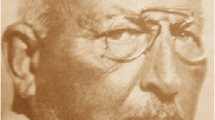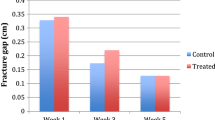Summary
Cartilaginous fetal bones from rat preserved by deep freezing procedures were compared to comparable fresh bones with regard to the following parameters: chemical composition, water and uronic acid contents; cell viability measured by the rate of proteoglycan synthesis; mineralizationossification status by calcium binding; matrix integrity by the release of uronic acid containing substances; and biological activity as transplants inducing the formation of bone. The transplanted material was chemically analyzed and checked for its rate of proteoglycan synthesis. The quality of the formed bone was similar whether isogeneic or allogeneic, fresh or cryopreserved bone was employed as transplant material. Evidently those various fetal bones may be of clinical value whenever the need for replacement of massive bone loss arises. Although the viability and the cartilaginous nature of the graft are critical, the isogeneity and freshness are of a quantitative advantage only. These biochemical observations were confirmed by roentgenological and histological evaluations of the grafts. An optimal cryopreserving procedure and tests for examining bone candidates for successful grafting are described.
Similar content being viewed by others
References
Trueta J (1968) Bone implants. In Trueta J (ed): Studies of the Development and Decay of the Human Frame. William Heinemann Ltd, London, pp 176–186
Gibson T (1968) Bone and cartilage transplantion. In Rapaport FT, Dausset J (eds): Human Transplantation. Grune and Stratton, New York, pp 313–331
Steinman C (1947) The healing of drill-hole defects in the long bone of adult rabbits, especially following the use of embryonic bone transplants. Anat Rec 99:427–441
Gordon SD, Warren RF (1948) Homogenous fetal cartilage grafts to bone. Ann Surg 127:90–97
Chalmers J, Ray RD (1962) The growth of transplanted foetal bones in different immunological environments. J Bone Joint Surg 44B:149–164
Huggins CB, Anderson KB (1976) Growth of transplanted tails of infant rats in adolescent allogeneic recipients. Proc Natl Acad Sci USA 73:3283–3287
Thyberg J, Moskalewski S (1979) Bone formation in cartilage produced by transplanted epiphyseal chondrocytes. Cell Tissue Res 104:77–94
Siegal T, Marcus ZH (1972) Studies on orthotopic homografts and allografts of rat fetal bones. Proc XII SICOT Congr Exc Med ICS 291:142–167
Siegal T, Segal S, Nevo Z, Lev El A, Altaratz C, Katznelson A, Nebel L (1977) Replacement of massive bone loss by fetal bone transplantation: Biochemical and immunologic aspects. Transplant Proc 9:351–353
Segal S, Siegal T, Altaratz H, Lev El A, Nevo Z, Nebel L, Katzenelson A, Feldman M (1979) Bone fetal bone grafts do not elicit allograft rejection, due to protecting anti-Ia alloantibodies: Implications to the immune survival of fetuses in allogenic mothers. Transplantation 28:88–95
Gibson T (1957) Viability of cartilage after freezing. Proc R Soc Lond [Biol] 147:528–529
Smith AU (1965) Survival of frozen chondrocytes isolated from cartilage of adult animals. Nature 205:782–784
Boyne PJ (1968) Review of the literature on cryopreservation of bone. Cryobiology 4:341–357
Lowe C, Smith AU (1975) Isolation, freezing and storage of rabbit growth plate chondrocytes. Lab Pract 24:511–514
Kukwa A, Wiecko J, Hinek A, Kurnatowski W (1977) Evaluation of preserved allogenic grafts of rabbit costal cartilage with live perichondrium. Acta Med Pol 18:19–27
Schachar NS, Mankin D, Lippiello L, Mankin JJ (1977) The use of glycerol and dimethylsulfoxide (DMSO) in the cryopreservation of articular cartilage prior to allograft transplantation. Trans Orthop Res Soc 2:271
Brighton CT, Shadle CA, Jimenez SA, Lipton M (1979) Articular cartilage preservation and storage. I. Application of tissue culture techniques to the storage of viable articular cartilage. Arthritis Rheum 22:1093–1101
Dische Z (1947) A new specific color reaction of hexuronic acids. J Biol Chem 167:189–197
Oegema TR, Hascall VC, Dziewiatkowski DD (1975) Isolation and characterization of proteoglycans from the Swarm rat chondrosarcoma. J Biol Chem 250:6151–6159
Nevo Z, Horwitz AL, Dorfman A (1972) Synthesis of chondromucoprotein by chondrocytes in suspension culture. Dev Biol 28:219–228
Dziewiatkowski DD (1958) Autoradiographic studies with35S-sulfate. Int Rev Cytol 7:159–193
Curran RC, Gibson T (1956) The uptake of labeled sulfate by human cartilage cells and its use as a test of viability. Proc R Soc Lond [Biol] 144:572–576
Pearce AG (1968) Histochemistry Theoretical and Applied, vol. 1. Churchill Livingstone Ltd, London
Glowacki J, Kaban LB, Murray JE, Folkman J, Mulliken JB (1981) Application of the biological principle of induced osteogenesis for craniofacial defects. Lancet: 959–963
Urist MR (1965) Bone formation autoinduction. Science 150:893–899
Reddi AH, Huggins CB (1972) Biochemical sequences in the transformation of normal fibroblasts in adolescent rats. Proc Natl Acad Sci USA 69:1601–1605
Wilson PD (1947) Experiments with a bone bank. Ann Surg 126:932–946
Nevo Z, Lev El A, Siegal T, Segal S, Altaratz C, Dolev S (1977)35S,45Ca incorporation and matrix integrity: valuable parameters for deep-frozen fetal bones for transplantation. Isr J Med Sci 12:975–976
De Palma AF, Tsaltas TT, Mauler GG (1963) Viability of osteochondral grafts as determined by uptake of S35. J Bone Joint Surg 45:1565–1578
Reynolds FC, Oliver DR, Ramsey R (1951) Clinical evaluation of the merthiolate bone bank and homogenous bone grafts. J Bone Joint Surg 33A:873–883
Cleland HN, Sevastikoylan JA (1962) Experimental studies of embryonic bone transplantation. Acta Orthop Scand 32:1–26
Shimomura Y, Yoneda T, Suzuli F (1975) Osteogenesis by chondrocytes from growth cartilage of rat rib. Calicif Tissue Res 19:179–187
Serafini-Fracassini A, Smith JW (1974) The Structure and Biochemistry of Cartilage (Calcification of Cartilage). Churchill Livingstone, Edinburgh and London, pp 195–205
Meryman HT (1974) Freezing injury and its prevention in living cells. Ann Rev Biophys Bioeng 3:341–363
Matthews JL, Martin JH, Collins EJ (1970) Intracellular calcium in epithelial, cartilage and bone cells. Calcif Tissue Res 4:37–39
Groer PG, Marshall JH (1973) Mechanism of calcium exchange at bone surfaces. Calcif Tissue Res 12:175–192
Sandborn SB, Stephens H, Bendayan M (1975) The influence of dimethylsulfoxide on cellular ultrastructure. Ann NY Acad Sci 243:122–138
Hirschman A, Dziewiatkowski DD (1966) Proteinpolysaccharide loss during endochondral ossification: Immunochemical evidence. Science 154:393–395
Urist MR, Speer DP, Ibsen KJ, Strates BS (1968) Calcium binding by chondroitin sulfate. Calcif Tissue Res 2:253–261
Pita JC, Cuervo LA, Modgura JE, Muller EJ, Howell DS (1970) Evidence for a role of the proteopolysaccharides in regulation of mineral phase separation in calcifying cartilage. Clin Invest 49:2188–2197
Smith QT, Lindenbaum A (1971) Composition and calcium binding protein-polysaccharides of calf nasal septum and scapula. Calcif Tissue Res 7:290–298
Reddi AH, Hascall VC, Hascall GK (1978) Changes in proteoglycan types during matrix-induced cartilage and bone development. J Biol Chem 253:2429–2436
Reddi AH, Anderson WA (1976) Collagenous bone matrix-induced endochondral ossification and hemopoiesis. J Cell Biol 69:557–572
Von der Mark K, von der Mark H (1977) The role of three genetically distinct collagen types in endochondral ossification and calcification of cartilage. J Bone Joint Surg 59:458–464
Iwata H, Urist MR (1973) Hyaluronic acid production and removal during bone morphogenesis in implants of bone matrix in rats. Clin Orthop Rel Res 90:236–245
Vittur E, Pugliarello MC, De Bernard B (1972) The calcium binding properties of a glycoprotein isolated from preosseous cartilage. Biochem Res Commun 48:143–152
Ennever J, Vogel JJ, Levy BM (1974) Lipid bone, in matrix calcification in vitro. Proc Soc Exp Biol Med 145:1386–1388
Pita JC, Howell DS, Kuettner HK (1975) Evidence for a role of lysozyme in endochondral calcification during healing of rickets. In Slavkin HC, Greulich RC (eds): Extracellular Matrix Influences Gene Expression. Academic Press, New York, pp 721–726
Author information
Authors and Affiliations
Rights and permissions
About this article
Cite this article
Nevo, Z., Lev-El, A., Siegal, T. et al. Fresh and cryopreserved fetal bones replacing massive bone loss in rats. Calcif Tissue Int 35, 62–69 (1983). https://doi.org/10.1007/BF02405008
Issue Date:
DOI: https://doi.org/10.1007/BF02405008




